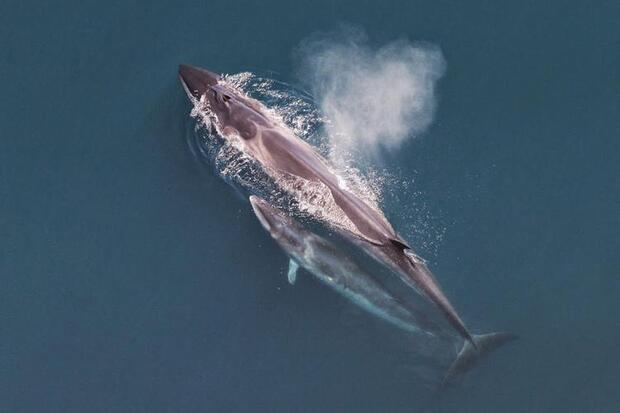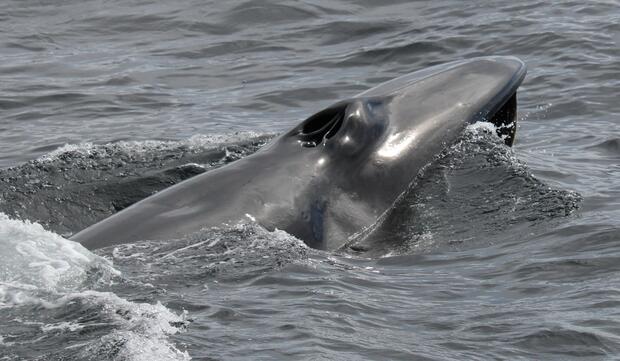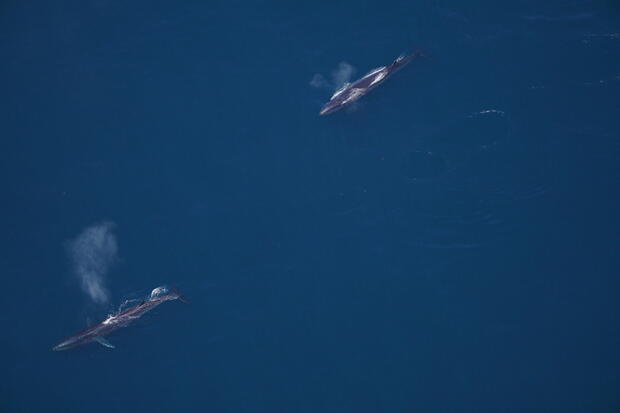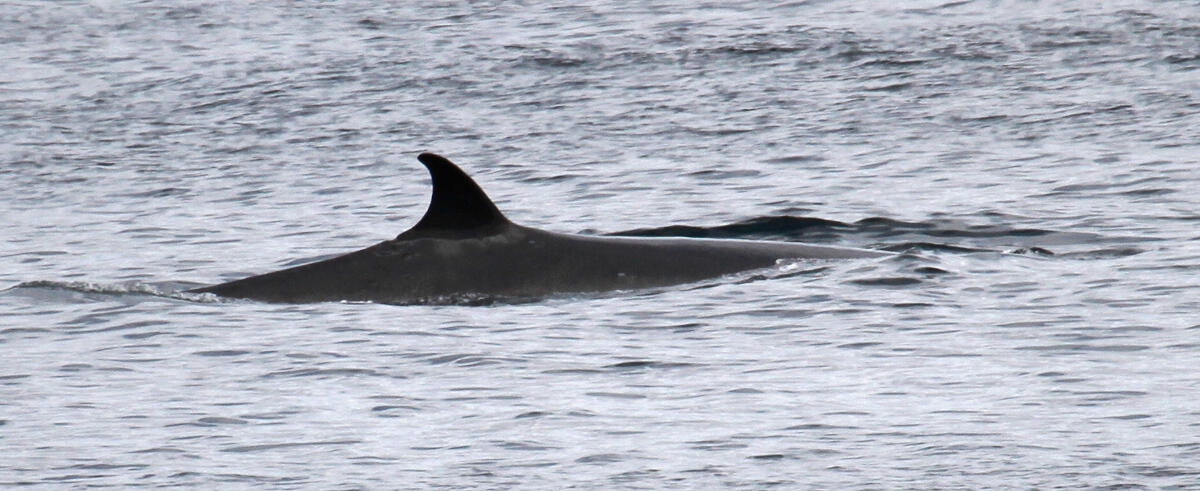- Scientific name: Balaenoptera borealis
- Species of Greatest Conservation Need (MA State Wildlife Action Plan)
- Endangered (MA Endangered Species Act)
- Endangered (US Endangered Species Act)
Description
Sei whales grow to 12-18 m (40-60 ft) and weigh up to 41 mt (50 tons; NOAA 2025). They have a long sleek body that is dark bluish-gray to black with paler coloration to white underneath. Their body is often covered in oval-shaped scars thought to result from lamprey and cookie-cutter shark bites. The dorsal fin is about 25-60 cm (10-24 inches) high, located roughly two-thirds of the way back along the body, with a sharply-angled tip. To differentiate sei whales from fin whales, look for a uniform dark color on both sides of the lower jaw and on the baleen all the way around the mouth, a more sharply angled dorsal fin, and a generally smaller and sleeker body. Sei whale baleen is dark in color, with grayish-white fine inner fringes. Their mouths contain 219-410 baleen plates.
Life cycle and behavior
Sei whales live between 50 and 70 years, reaching sexual maturity at 6 to 12 years and around 15 m (45 ft) in length. Females breed every 2 to 3 years and have a gestation period of approximately one year, with breeding and calving occurring during late fall and winter in lower latitudes. Mating peaks in December and January. Calves are about 5 m (15 ft) long and about 680 kg (1500 lbs) when born. Calves nurse for 6 to 9 months until weaned on the feeding grounds. Sei whales have few predators but killer whales and larger sharks will prey on them.
Sei whales usually travel singly or in small groups of 2 to 5 animals and can travel at speeds over 48 kph (30 mph). Occasionally, they are found in larger loose aggregations of 30 to 50 individuals. The species’ diet mainly consists of zooplankton (such as copepods and krill), small schooling fish, and squid. They prefer to feed at dawn and can dive for 5 to 20 minutes to retrieve prey. They eat up to 907 kg (2000 lbs) a day. When feeding, they sink into the water without arching their backs to dive.
Population status
The sei whale is classified as an endangered species in Massachusetts and under the federal Endangered Species Act. Commercial whaling was a major historic cause of population decline. The current worldwide population is estimated to have grown to about 80,000 since whaling was outlawed. Although sei whales are considered to be relatively abundant in the North Atlantic and North Pacific oceans, populations in the Southern Oceans remain severely depleted.
Distribution and abundance
The sei whale can be found in all the world’s oceans, excluding tropical and extreme polar seas (NOAA 2025). The species prefers subtropical and subpolar waters. In the western North Atlantic, it seasonally ranges from Greenland and Iceland south to the Caribbean and Gulf of Mexico. Sei whales move north in the early spring to feed in the Gulf of Maine and Canadian waters. The southern edge of the summer feeding range extends south to New Jersey. In the winter (November-February), they are found from Georges Bank off New England, south to the West Indies. The location of the breeding grounds is unknown.
The distribution of sei whales is dependent on where concentrations of zooplankton have formed. These whales may unexpectedly show up in large numbers to feed on these concentrations. They are often joined by basking sharks and other species of baleen whales.
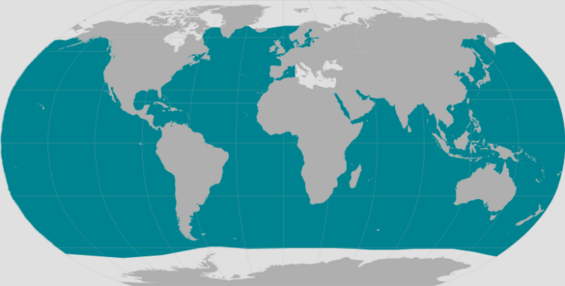
Approximate sei whale range (NOAA Fisheries)
Habitat
Sei whales are most abundant off Massachusetts in the spring when they concentrate along the eastern and southwestern edges of Georges Bank, into the Northeast Channel, and south of Nantucket. They occur in the vicinity of Georges Bank year-round. They generally stay offshore in deeper water, so are seldom seen, but as many as 40 were in Cape Cod Bay in April 2017, along with North Atlantic right whales and other species. The species is considered to be relatively abundant in the North Atlantic.
Healthy habitats are vital for supporting native wildlife and plants. Explore habitats and learn about conservation and restoration in Massachusetts.
Threats
Major threats to sei whales are vessel strikes, fishing gear entanglement, ocean noise and climate change. Vessel strikes injury or kill sei whales. The risk of vessel strikes will likely increase as polar ice melts and new routes are open to increasingly more shipping traffic. Fishing gear entanglement can cause fatigue, decrease feeding, and result in injuries that decrease reproductive success and result in mortality. Ocean noise disrupt normal behaviors including migration and can result in strandings. Climate change is changing oceanic conditions, including distributions and concentrations of prey available for feeding.
Conservation
The National Oceanic and Atmospheric Administration published their sei whale recovery plan in 2011 (NOAA 2025). Major conservation actions recommended are to:
- Reduce or eliminate injury or mortality caused by vessel strikes,
- Reduce or eliminate injury and mortality caused by fisheries and fishing gear,
- Protect habitats essential to the survival and recovery of sei whales,
- Minimize effects of vessel disturbance,
- Continue international ban on hunting and other directed take,
- Monitor the population size and trends in abundance,
- Maximize efforts to free entangled or stranded sei whales, and
- Acquire scientific information from dead specimens.
Stranded whales should be reported to the Marine Mammal Rescue and Research in Cape Cod at 508-743- 9548 or the National Marine Fisheries Service at 866-755-NOAA, 866-755-6622.
References
National Marine Fisheries Service. 2021. Sei whale (Balaenoptera borealis) 5-year Review. National Marine Fisheries Service, Office of Protected Resources, Silver Spring, MD. 57 pp.
NOAA [National Oceanic and Atmospheric Administration]. 2025. Species directory: sei whale conservation and management. Available at: Sei Whale: Conservation & Management | NOAA Fisheries. Accessed on 7/4/25.
Contact
| Date published: | July 7, 2025 |
|---|
